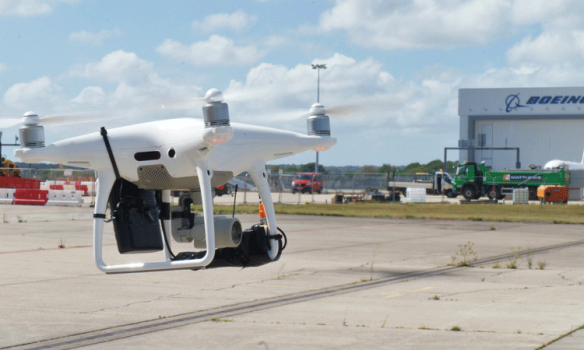K
Kathleen Martin
Guest
When drones began to be used more widely by the public, initially the aviation industry’s assessment classed them as a threat, posing a risk to aircraft and potentially infrastructure and passengers as well. In reaction, airports focused on attempts to detect, protect, and defend against them. This feeling was fuelled by increasing cases of drones straying into protected airspace and culminated in a surge in drone-defence activities for airports following the Gatwick drone incident in December 2018.
However, in the three years since, the value that drones can offer has been increasingly recognised by the industry. Drones are now used by businesses to deliver small items to customers, by emergency services in life-saving scenarios to search for injured people in remote locations, and by airports to inspect buildings.
In 2021, ANSL carried out its own drone flight trials at Gatwick Airport (LGW). It used its integrated Drone Operations on Airports concept to prove the feasibility of structural inspections, thermal inspections to identify sources of heat leaks on airport facilities, and lighting inspections, to name just a few.
Today, the drone industry continues to grow at an increasingly fast pace; in January 2021, there were 1,782,479 drones registered in the U.S. alone. It is therefore inevitable that they will remain a part of our future and our airspace. With this in mind, airports and other key stakeholders are turning their attention away from prevention to focus on safe integration into the airfield and beyond.
Whilst on-airport operations of drones require integration from an airport traffic and infrastructure perspective, inevitably any drone flying on, and above, airports would be utilising the associated airspace as well. Potential future use-cases, such as transport of spare parts, delivery of priority items and the deployment of cargo drones and air taxis, quickly lead to the challenge of on- and off-airport transition.
At this point, the focus shifts and the wider challenge of airspace integration becomes more pressing. In comparison to airports which generally are well known, comprehensively surveyed and tightly controlled spaces, the wider airspace introduces the challenge of the unknown.
When considering the integration of drones into airspace, it is the uncontrolled airspace, the remote areas and the less occupied parts that may require the most attention. How can drones be integrated into rescue helicopter traffic that is responding to ad-hoc requirements in remote locations not covered by today’s surveillance solutions? How can drones safely co-exist with general aviation operating at their leisure with no flight plan without posing a risk or leading to constraint? These are the questions that need answering and, together with concepts for the integration into high-intensity environments such as airports, will provide a solid concept for scalable, safe, and efficient integration of drones into the future of air travel.
Continue reading: https://www.internationalairportreview.com/article/173958/integrating-drones-into-airspace/
However, in the three years since, the value that drones can offer has been increasingly recognised by the industry. Drones are now used by businesses to deliver small items to customers, by emergency services in life-saving scenarios to search for injured people in remote locations, and by airports to inspect buildings.
In 2021, ANSL carried out its own drone flight trials at Gatwick Airport (LGW). It used its integrated Drone Operations on Airports concept to prove the feasibility of structural inspections, thermal inspections to identify sources of heat leaks on airport facilities, and lighting inspections, to name just a few.
Today, the drone industry continues to grow at an increasingly fast pace; in January 2021, there were 1,782,479 drones registered in the U.S. alone. It is therefore inevitable that they will remain a part of our future and our airspace. With this in mind, airports and other key stakeholders are turning their attention away from prevention to focus on safe integration into the airfield and beyond.
Whilst on-airport operations of drones require integration from an airport traffic and infrastructure perspective, inevitably any drone flying on, and above, airports would be utilising the associated airspace as well. Potential future use-cases, such as transport of spare parts, delivery of priority items and the deployment of cargo drones and air taxis, quickly lead to the challenge of on- and off-airport transition.
At this point, the focus shifts and the wider challenge of airspace integration becomes more pressing. In comparison to airports which generally are well known, comprehensively surveyed and tightly controlled spaces, the wider airspace introduces the challenge of the unknown.
When considering the integration of drones into airspace, it is the uncontrolled airspace, the remote areas and the less occupied parts that may require the most attention. How can drones be integrated into rescue helicopter traffic that is responding to ad-hoc requirements in remote locations not covered by today’s surveillance solutions? How can drones safely co-exist with general aviation operating at their leisure with no flight plan without posing a risk or leading to constraint? These are the questions that need answering and, together with concepts for the integration into high-intensity environments such as airports, will provide a solid concept for scalable, safe, and efficient integration of drones into the future of air travel.
Continue reading: https://www.internationalairportreview.com/article/173958/integrating-drones-into-airspace/

